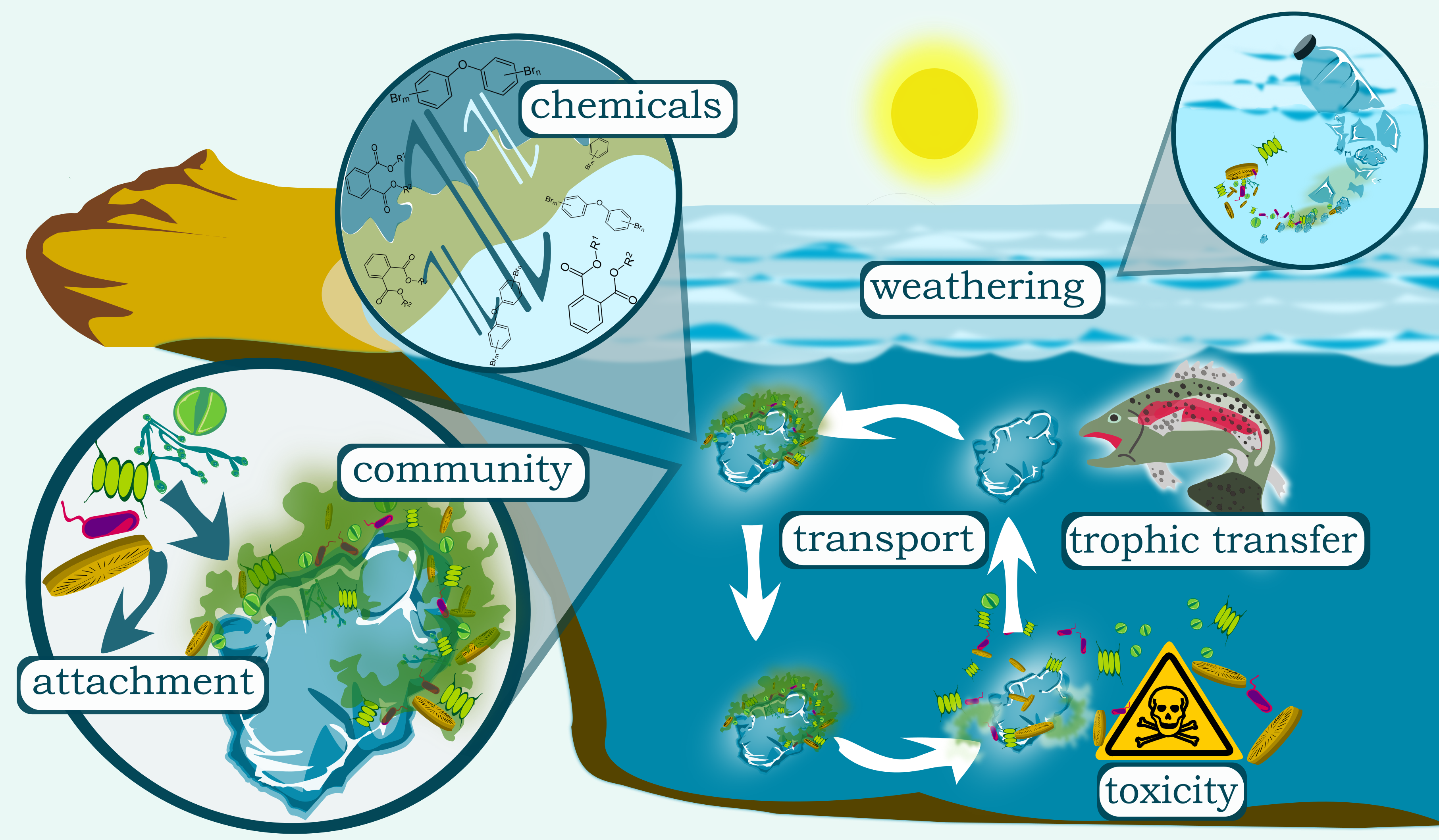Effects on aquatic organisms
Our research work is focussed on the aquatic ecotoxicity assessment of nano- and microplastic particles, as well as the chemicals that are associated to the particles. Several aquatic organisms from autotrophs (e.g. green algae) to heterotrophs, from invertebrates (e.g. water flea) to vertebrates (e.g. zebrafish embryos), from single organisms to communities (e.g. biofilm communities living attached to surfaces) are applied for effect assessment.
The identification of plastic particle hazard also includes the characterisation of organism-particle interaction, by the assessment of attachment of organisms to surfaces, internalisation and distribution of particles in environmental organisms. For this, several micropscopic and spectroscopic methods can be used.
The findings from the hazard identification are finally incorporated into a microplastic risk assessment.
Projects:
- PlasticsFatE - Plastics Fate and Effects in the human body (EU), 01.04.2021 - 31.03.2025
- P-LEACH (2022-2024)
- InnoMatLife - Innovative materials and new production processes: Safety in the life cycle and industrial value creation; (BMBF) 01.04.2019 - 31.03.2022; Ecotoxicological assessment of plastics particles relevant in 3D printing
- MICRO-FATE – Characterizing the fate and effects of microplastic particles between hotspots and remote regions in the Pacific Ocean’ (BMBF, 2019-2021)
- WeatherMIC - How weathering processes influence the transport, fate and toxicity of microplastics (MPs) and their leachates in the marine environment (JPI Oceans), 2016 - 2018
Contributing Scientists:
 Illustration of the complex interactions of biofilms and plastics. (Figure from Rummel et al., 2017)
Illustration of the complex interactions of biofilms and plastics. (Figure from Rummel et al., 2017)
Publications:
- Jemec Kokalj, A., Kühnel, D., Puntar, B., Žgajnar Gotvajn, A., Kalčikova, G. (2019) An exploratory ecotoxicity study of primary microplastics versus aged in natural waters and wastewaters. Environ. Pollut. 254 , art. 112980.
- Potthoff, A., Oelschlägel, K., Schmitt-Jansen, M., Rummel, C.D., Kühnel, D. (2017) From the sea to the laboratory: Characterization of microplastic as prerequisite for the assessment of ecotoxicological impact. Integr. Environ. Assess. Manag. 13 (3), 500 - 504.
- Rummel, C.D., Jahnke, A., Gorokhova, E., Kühnel, D., Schmitt-Jansen, M. (2017) Impacts of biofilm formation on the fate and potential effects of microplastic in the aquatic environment. Environ. Sci. Technol. Lett. 4 (7), 258 - 267.
- Guasch, H., Bernal, S., Bruno, D., Carney Almroth, B., Cochero, J., Corcoll, N., Cornejo, D., Gacia, E., Kroll, A., Lavoie, I., Ledesma, J.L.J., Lupon, A., Margenat, H., Morin, S., Navarro, E., Ribot, M., Riis, T., Schmitt-Jansen, M., Tlili, A., Martí, E. (2022) Interactions between microplastics and benthic biofilms in fluvial ecosystems: Knowledge gaps and future trends. Freshw. Sci. 41 (3), 442 – 458.
- Rummel C.D., Schäfer H.,Arp HP., Jahnke A., Schmitt-Jansen M.(2022). Effects of leachates from UV-weathered microplastic on the microalgae Scenedesmus vacuolatus. Analytical and Bioanalytical Chemistry. 414 (4), 1469 – 1479.
- Rummel C.D., Lechtenfeld O.J., Kallies R., Benke A., Herzsprung P., Rynek R., Wagner S., Potthoff A., Jahnke A., Schmitt-Jansen M. (2021) Conditioning film and early biofilm succession on plastic surfaces. Environ. Sci. Technol. 55 (16), 11006 – 11018.
- Arp HP., Kühnel D., Rummel Ch., MacLeod M., Potthoff A., Reichelt S., Rojo-Nieto E., Schmitt-Jansen M., Sonnenberg J., Toorman E. Jahnke A. (2021) Weathering Plastics as a Planetary Boundary Threat: Exposure, Fate, and Hazards. Environ. Sci. Technol. 2021, 55, 7246−7255.
